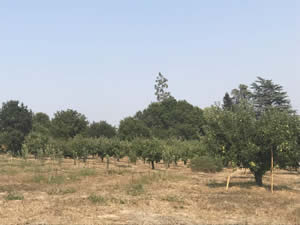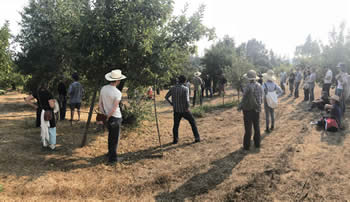Latest News
Cider Apple Farm Revives Heirloom Orchard and Plans for a Changing Future

On Wednesday, August 8, members of the apple farming community gathered in Sebastopol around a vanguard in the local movement for innovative orchard management: Apple Bottom Farm.
Ned Lawton, owner of Apple Bottom Farm and Founder of Ethic Ciders, was excited to greet the group of 45 or so attendees at the Farmer-to-Farmer Field Day event organized by the Farmers Guild. The attendees, many of whom were either apple farmers or cider industry professionals, were eager to hear from Apple Bottom Farm’s team about their explorations of climate-adapted cider apple varieties. The management team strives for “farming as stewardship.” This effort is supported by a carbon farm plan, recently completed in partnership with the Gold Ridge RCD.
Lawton explained that behind the efforts at Apple Bottom Farm is his mission to keep Sonoma County apple agriculture alive and thriving. He recognized that in order to do so, their farm would need to produce something truly significant. The result: local, sustainable, exquisite cider. Lawton and his wife are first-generation farmers with a desire to bring their family and friends closer to nature. In 2015, two years after the purchase of the two-and-a-half-acre organic heirloom apple farm, a cidery emerged. Ethic Ciders, a cidery “rooted in relationship to the land,” was born. Ned and his wife Michele Lawton felt that delicious cider would be the avenue for revitalizing both the apple orchard itself and their community’s relationship to the land.
Ryan Johnston joined the team as Orchard Manager and Cidermaker in 2016 for Ethic Ciders’ first commercial harvest. Johnston brought a new focus on regenerative agriculture to the apple farming operation. With the support of a close friend and consultant, August York of Intuit Ag Consulting, the Ethic Ciders team began their inspired work to make Apple Bottom Farm a flagship operation centered on principles of regenerative land management.
Johnston and York toured attendees down the orchard’s rows, pointing to the irrigation, cultivation, and floor management practices. Side conversations abound as farmers poked their heads in the boughs, and pointed to the ground, talking shop and waiting for the opportunity to ask the hosts their questions. In a row of Wickson-producing apple trees, Johnston pointed to the joints where new grafts met decade’s old Golden Delicious rootstock, highlighting the low-impact method of “top working” to change apple varieties in an established orchard.
“To grow healthy trees, we have to make sure the building blocks of health are present,” Johnston explains, and that means healthy soils. With York’s guidance, they pull soil samples each summer that inform the management team’s decisions around adding fertility amendments in autumn to the orchard’s floor. In the spring, leaf tissue samples are analyzed to determine if the trees are up-taking the nutrients. Subsequent foliar sprays are applied to correct for any deficiencies. Compost tea, rich in beneficial microbes, is applied to the orchard floor after each spring mowing. Johnston says the hypothesis they are testing is that “a healthy orchard ecosystem actually produces more complex and desirable flavors in its fruit.”
York emphasizes the important role of soil health in the system. “By testing and amending to address nutrient deficiencies, we’re able to more precisely and thus economically address limiting factors to plant health. We’re also continually working to increase soil life, because it’s these microorganisms that make the nutrients available to the plants in an organic system.” Healthy soils not only provide nutrients to the plant and flavor to the fruit, they also provide a service to the climate. The concept of carbon farming is based in substantial research that healthy soils are a carbon sink.
After the flavorful cider apples have been harvested, the orchard team scatters a diverse blend of cover crop mix (brassicas, clovers, legumes and grass seeds), spreads compost and minerals, and disturbs the soil surface just slightly to cover and incorporate the seed. Compost application and cover crop establishment are two highly beneficial climate smart agriculture practices because they introduce organic matter into the soil and protect the soil surface from erosion. These steps prepare the ground for winter.

When spring comes, pollinators will be attracted to the orchard by the many blossoms on the trees. But Johnston knows that’s not enough forage to keep those bees, butterflies and birds supported all year round. A 465’ strip along the orchard’s fence line has been sheet-mulched in preparation for a perennial hedgerow of flowering plants that will provide native and drought-hearty blossoms year-round for those much-needed pollinators.
Practices that support healthy soil, build wildlife habitat, reduce fossil fuel use, and promote the long-term adaptiveness of the operation are all elements of the orchard’s Carbon Farm Plan. Apple Bottom Farm recently completed a carbon farm plan, developed in partnership with the Gold Ridge Resource Conservation District. The plan identifies both the existing climate-smart agriculture practices on the farm as well as the ones the land manager is interested in bringing on. The initiative to identify these practices comes from a large body of research supporting the idea that agricultural land uses, such as grazing on rangeland or farming apple trees, can significantly sequester atmospheric carbon dioxide through specific practices. The Carbon Farm Plan is intended to be a first step in documenting the practices that increase the farm’s carbon capture potential.
Through the planning process, the Apple Bottom Farm identified additional practices that could earn them increased carbon sequestration on site. These include spreading compost in the orchard rows, planting the hedgerow, mulching, and reducing tillage. The carbon sequestering potential of these practices was quantified using tools such as COMET Planner and Compost Planner. These quantifications are used when applying for funding; the greater the carbon capture, often the greater the funding awarded per project.
Current practices on the farm are bringing down 2.43 tons of carbon dioxide equivalent gases per year. This means those gases will be taken from the atmosphere where they can do harm warming the climate and brought into the organic body of the plants and soil on the ranch through the carbon cycle. If the additional practices outlined in the carbon farm plan are implemented as planned, over the next 20 years, they are expected to sequester 216 tons of carbon dioxide-equivalent gases. To put it in perspective, this is approximately equal to permanently removing 46 cars from our local roadways.
Conservation Practice (applicable NRCS Practice Standard #) |
Size Acres |
Carbon Dioxide (CO2) |
Nitrous Oxide (N2O) |
Methane (CH4) |
Total CO2 Equivalent |
Quantification Method* |
Compost Application (C/N>11) |
2.0 |
9.0 |
-0.3 |
8.7 |
COMPOST Planner |
|
Cover Crop to Non-Irrigated Cropland (CPS 340) |
2.0 |
1.0 |
-0.6 |
0.4 |
COMET-Planner |
|
Hedgerow (CPS 422) |
.14 |
1.1 |
0 |
N.E. |
1.1 |
COMET-Planner |
Mulching (CPS 484) |
2.0 |
0.6 |
0 |
0.6 |
COMET-Planner |
|
Reduced till to No-till (CPS 329) |
2.0 |
0.2 |
0 |
0 |
0.2 |
COMET-Planner |
Totals |
11.9 |
-0.90 |
0 |
11.0 |
||
The Carbon Farm Plan for Apple Bottom Farm has estimated the annual carbon sequestration and greenhouse gas emission reductions associated with implementation of the suggested conservation practices in the table above.
Implementing the additional practices identified in the plan is left to the landowner’s discretion. With each practice requiring work and financing, getting those practices off the paper and into reality can be a challenge and can take time. There are a number of funding options for farmers interested in funding climate-smart agricultural practices. Other than financing the activities themselves, they can apply for grant funding, mitigation funding, funding through voluntary markets or the cap and trade market. Johnston has secured three years of financial assistance from the USDA’s Natural Resources Conservation Service (NRCS)’s grant program. The NRCS is a federal agency that works with landowners who want to take voluntary conservation measures on their property. EQIP, the Environmental Quality Improvement Program, is currently the primary source of funding for the practices outlined in the Apple Bottom Farm’s Carbon Farm Plan.
While programs like these provide assistance, they also require the farmer’s commitment. EQIP requires the landowner to fund 50% of the practices. Other programs, such as the Healthy Soils Incentives Program funding through the CA Department of Food and Agriculture, will fund the first two years of a practice but require the farmer to pay for the third year. With each program also comes requirements around implementing the work to a specific standard. Technical service providers like NRCS and the RCDs aim to support the landowner along the way.
Lucky for all of us, funding assistance for climate-smart agriculture is growing. The Governor has a proposed budget for fiscal year 2018-19 of more than $5M in the Greenhouse Gas Reduction Fund (GGRF) and $9M in Prop. 68 funds. The Healthy Soils Program, managed by the state’s Department of Food and Agriculture, stems from the California Healthy Soils Initiative, a collaboration of state agencies and departments to promote the development of healthy soils on California’s farmlands and ranchlands.
When it comes to climate change, Johnston said his work is energized by the idea that action dispels despair. “Climate change is happening. But we can do something about it,” he said. “We continue to ask ourselves – how do we farm in such a way that increases the life-supporting capacity of this place through time?” At this point the Ethic Ciders team has more questions than answers, but they keep digging in and learning through experience. “Our operation is small, but we want to lead by example.”
In an article for the World Economic Forum, soil scientist David Burton wrote that global farmland restoration could be the answer to climate change and food security. “Improved soil management is a public good. We need economic tools and short-term incentives that encourage producers to adopt these practices for the good of all,” says Burton.
With climate solutions growing under our feet, farmers can help lead the way.